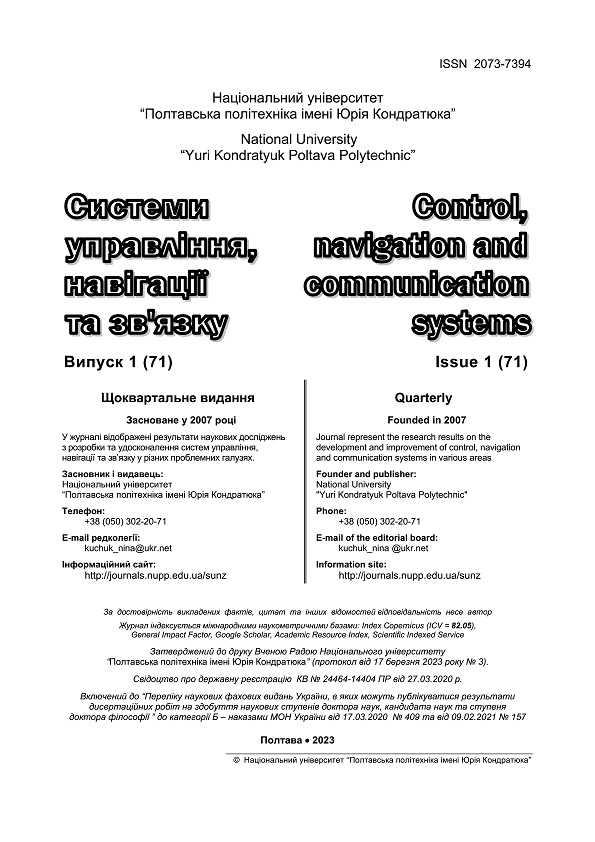НЕЙРОМЕРЕЖНЕ ЗАБЕЗПЕЧЕННЯ АВТОМАТИЗАЦІЇ УПРАВЛІННЯ ОБ’ЄКТОМ ПРИ БАГАТОФАКТОРНОМУ ВХІДНОМУ ВПЛИВІ В УМОВАХ НЕВИЗНАЧЕНОСТІ
DOI:
https://doi.org/10.26906/SUNZ.2023.1.046Ключові слова:
автоматична класифікація станів, аналіз даних, вектор вхідних факторів, нейронна мережа, цільова функціяАнотація
Висока розмірність факторів, їх зашумленість, суб’єктивізм людського фактору породжують підвищений ступінь невизначеності у реалізації ефективного моніторингу та продуктивного менеджменту сфер виробництва та споживання, перешкоджають прийняттю оптимальних рішень. В цих умовах доцільно застосувати інтелектуальні процедури аналізу даних у базисі штучних нейронних мереж. Мета дослідження – обґрунтувати технологію побудови ефективних нейромережних моделей автоматичної оцінки станів об’єкта та керування ними шляхом знаходження оптимальних значень вхідних факторів на основі аналізу множини ретроспективних даних. Шуканим продуктом є нейромережні моделі одночасної оцінки поточних станів об’єкта та розрахунку значень вхідних факторів, що забезпечують досягнення необхідних показників елементів цільової функції. Для автоматизації процесів розпізнавання станів об’єкта аналізу та адаптації факторів, що приводять поточний стан до цільового, знайдено функціональну залежність станів та факторів на основі примусового навчання ансамблю синтезованих моделей. Запропонована технологія дозволяє автоматизувати процеси класифікації станів об’єкту дослідження, адаптацію вхідних факторів до цільових станів та оцінити якість тестування моделей. Практична значимість результатів дослідження полягає у створенні універсального інструментарію для цілого класу об’єктів у завданнях автоматичної класифікації їх станів та пошуку простору вхідних факторів, адекватних простору цільових станів. Функціонально ансамбль навчених моделей може бути реалізований як програмний блок аналізу даних у форматі двох підсистем: розпізнавання станів об’єкта дослідження та адаптації вхідних факторів до цільових станів. Автоматизація завдань класифікації станів та адаптації вхідної множини на основі запропонованої технології, що виконується на базі стандартних пакетів технічного аналізу даних, дозволяє підвищити ефективність прийняття рішень та знизити матеріальні витрати при реалізації виробничих та комерційних проектів.Завантаження
Посилання
Haykin S. Neural Networks and Learning Machines. Prentice Hall, 2009. 906 p.
Buslenko N.P. Modeling of complex systems. 2nd Edition. - M.: Nauka, 1978. – 400 p.
Aloshyn S.P. Neural network basis for decision support in the space of factors and states of high dimension. Poltava: Skytech, 2013. – 208 pp.
Alyoshin S.P., Haitan O.M. Intelligent Technologies of Strategic Enterprise Management in the basis of Artificial Neural Networks // Modern engineering and innovative technologies, – Karlsruhe, Germany, – 2020. – Issue 14. Part 2. – P. 24-29.
Borovikov V.P. STATISTICA NN – Technical description. M.: Mir, 1999. – 239 p.
Podorozhniak, A., Liubchenko, N., Kvochka, M., & Suarez, I. (2021). Usage of intelligent methods for multispectral data processing in the field of environmental monitoring. Advanced Information Systems, 5(3), 97–102. https://doi.org/10.20998/2522-9052.2021.3.13
Olizarenko S., Radchenko V. (2021). Method for determining the semantic similarity of arbitrary length texts using the transformers models. Advanced Information Systems, 5(2), 126–130. https://doi.org/10.20998/2522-9052.2021.2.18
Alyoshin S.P., Haitan O.M. Neural network modeling of the process of non-invasive screening-analysis of oxygen saturation providing the invariance to the impact of masking factors // Modern engineering and innovative technologies. – Karlsruhe, Germany, – 2021. – Issue 16. Part 2. – P. 83-89.




